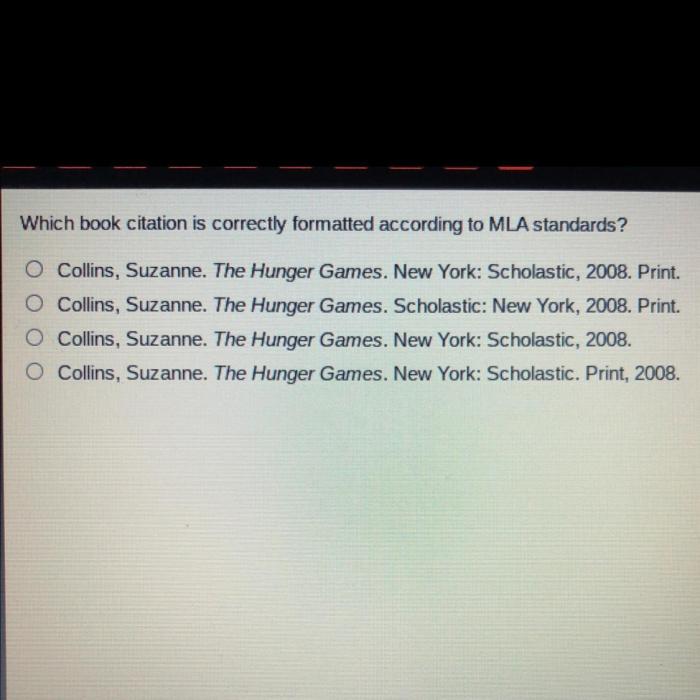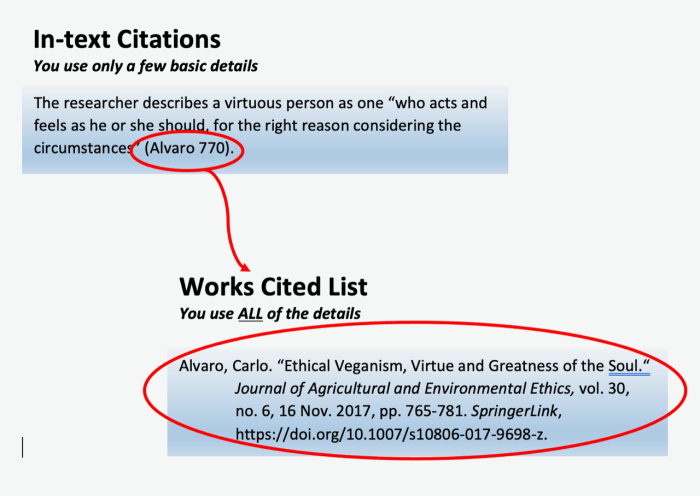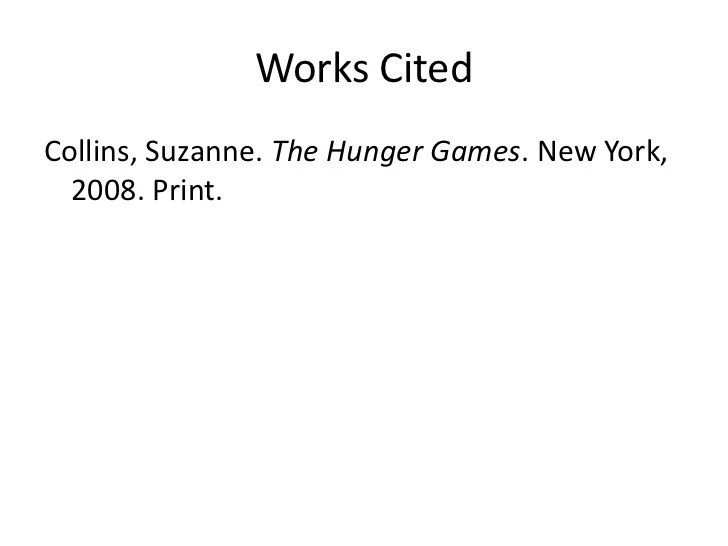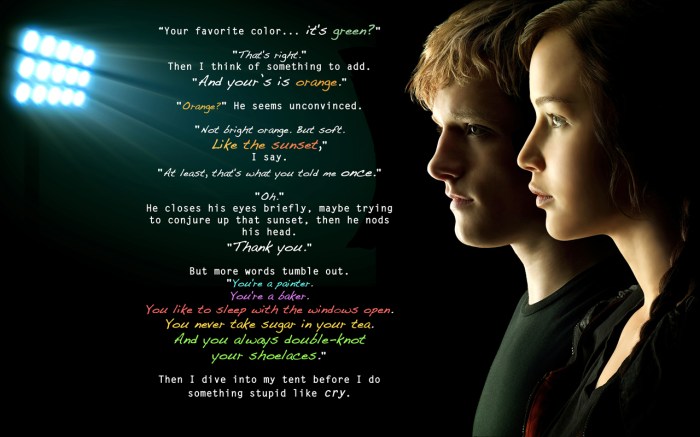The Hunger Games MLA citation, a crucial aspect of academic writing, ensures proper attribution and avoids plagiarism. This comprehensive guide will provide you with the knowledge and tools to format MLA citations for Suzanne Collins’s renowned novel.
Understanding the significance of MLA citations and their variations is essential. This guide will delve into the different styles, including in-text, parenthetical, and endnotes, explaining their appropriate usage with examples.
Introduction: The Hunger Games Mla Citation

The Hunger Games
The Hunger Games is a young adult dystopian novel series written by Suzanne Collins. It follows the story of Katniss Everdeen, a 16-year-old girl who volunteers to take her younger sister’s place in the Hunger Games, an annual event in which 24 teenagers are forced to fight to the death in a televised arena.
The series has been praised for its suspenseful plot, complex characters, and social commentary.
MLA Citation
MLA (Modern Language Association) citation style is a set of guidelines used to format sources in academic writing. It provides a consistent way to cite books, articles, websites, and other sources. Using MLA citation is important because it allows readers to easily identify and locate the sources used in a research paper or other academic work.
Variations in MLA Citation Styles
MLA citation styles offer several variations to accommodate different writing needs and preferences. These variations include in-text citations, parenthetical citations, and endnotes.
In-Text Citations
In-text citations are brief references to sources embedded within the text. They consist of the author’s last name and the page number where the cited material appears. For example:
“The Hunger Games is a dystopian novel that explores the themes of survival and rebellion” (Collins 123).
Parenthetical Citations
Parenthetical citations provide more detailed information than in-text citations. They include the author’s last name, the year of publication, and the page number. For example:
“The novel’s protagonist, Katniss Everdeen, is a complex and compelling character” (Collins, 2008, 123).
Endnotes
Endnotes are notes placed at the end of a chapter or the entire work. They provide extensive information about sources, including full bibliographic citations and additional commentary. Endnotes are often used in academic writing to avoid interrupting the flow of the text.
Examples of MLA Citations

When citing “The Hunger Games” in MLA style, there are several variations depending on the format required. Here are some examples to illustrate these variations:
In-Text Citations
In-text citations are used to give credit to the source of information within the body of the text. They typically include the author’s last name and the page number(s) from which the information was taken.
| Format | Example |
|---|---|
| Author-Page | (Collins 12) |
| Parenthetical | Collins states that “the Hunger Games are a televised event” (12). |
Parenthetical Citations
Parenthetical citations are similar to in-text citations, but they are enclosed in parentheses and placed at the end of the sentence or clause.
| Format | Example |
|---|---|
| Author-Page | (Collins 12) |
| Parenthetical | The Hunger Games are “a televised event” (Collins 12). |
Endnote Citations
Endnote citations are placed at the end of the paper and provide more detailed information about the source. They typically include the author’s name, title of the work, publication information, and page numbers.
| Format | Example |
|---|---|
| Endnote |
|
Using MLA Citations in Academic Writing

MLA citations are crucial in academic writing to avoid plagiarism and give credit to the sources you use. They ensure that your work is original and based on research, and they help readers find the sources you cited.
To incorporate MLA citations into your writing, you can use parenthetical citations within the text and a Works Cited page at the end of your paper. Parenthetical citations include the author’s last name and the page number from which you obtained the information.
For example, if you are citing a book by Jane Doe on page 123, you would write (Doe 123) at the end of the sentence where you used the information.
In-text Citations, The hunger games mla citation
In-text citations provide brief information about the source you are using. They typically include the author’s last name and the page number(s) of the source being cited. For example, if you are citing a book by Jane Doe on page 123, you would write (Doe 123) at the end of the sentence where you used the information.
In-text citations can be used in a variety of ways, including:
- At the end of a sentence:
- In the middle of a sentence:
- In parentheses:
Jane Doe argues that the world is flat (Doe 123).
According to Jane Doe, the world is flat (Doe 123).
The world is flat (Doe 123).
No matter how you choose to use in-text citations, be sure to be consistent throughout your paper.
For your “The Hunger Games” MLA citation, be sure to include the author’s name, the title of the work, the publisher, the date of publication, and the page numbers. If you need a case brief example, check out Meinhard v.
Salmon . For more information on MLA citations, refer to the MLA Style Manual.
Works Cited Page
The Works Cited page is a list of all the sources you cited in your paper. It should be placed at the end of your paper and should be formatted according to MLA style. Each entry on the Works Cited page should include the following information:
- The author’s name
- The title of the source
- The publication information (e.g., the publisher, the date of publication, the page numbers)
The entries on the Works Cited page should be listed alphabetically by the author’s last name. For example, if you are citing a book by Jane Doe, the entry on the Works Cited page would look like this:
Doe, Jane. _The World is Flat_. New York: Flat Earth Press, 2023.
For more information on MLA citations, please consult the MLA Style Manual or your instructor.
MLA Citation Generator

In the digital age, we have access to a wealth of online tools that can make our academic lives easier. One such tool is the MLA citation generator. These generators are designed to help you create accurate and consistent MLA citations with just a few clicks.
Using an MLA citation generator is simple. First, you will need to select the type of source you are citing (e.g., book, article, website). Then, you will need to enter the relevant information about the source, such as the author’s name, the title of the work, and the publication date.
Once you have entered all of the necessary information, the generator will create a properly formatted MLA citation for you.
Benefits of Using an MLA Citation Generator
- Accuracy:MLA citation generators are programmed to follow the latest MLA guidelines, ensuring that your citations are accurate and up-to-date.
- Consistency:When you use an MLA citation generator, you can be sure that all of your citations will be formatted in the same way. This consistency makes your writing look more polished and professional.
- Time-saving:Manually creating MLA citations can be a time-consuming process. MLA citation generators can save you a lot of time by automating this task.
FAQ Explained
What are the essential elements of an MLA citation for The Hunger Games?
Author’s name, title, publication information, and page numbers (if applicable).
How do I use an MLA citation generator?
Follow the instructions provided by the generator and input the necessary information accurately.